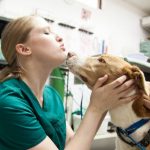This article was updated on October 9th, 2022
Arthritis in older dogs is a very common problem. In fact research indicates that approx. 60% of dogs over the age of eight years old are likely to develop arthritic symptoms as they continue to age (This study found that 80% of dogs over the age of eight have the condition).
So, it’s not surprising that a lot of has research been done, and a whole slew of products and medications designed to help dogs with joint pain.
If you’re looking for treatment options for arthritis in dogs, CLICK HERE
Osteoarthritis is the degenerative form of this disease (also known as ‘Degenerative Joint Disease or DJD). It is what is most often seen in older dogs. ‘Degenerative’ means that it’s an ongoing condition and it’s the result of a gradual deterioration of the cartilage which cushion your dog’s joints.
As the cartilage thins, inflammation, fluid and bone spurs (growths) occur and these lead to the painful symptoms we all associate with arthritis – whether human or canine. The joints most often affected are the hips, knees, elbows and lower back.
Canine Arthritis Symptoms
The main symptoms of the onset of canine osteoarthritis are fairly generalized:
- Overall stiffness
- Difficulty getting up in the morning (or after a nap)
- Overall ‘slowing down’, less interest in walks/games
- Reluctance to get in/out of the car or up/down from sofa
- Lameness or a limp (may well be intermittent early on)
Your senior dog might not show signs that he’s in pain, at least to begin with, so it’s important to be aware that the symptoms above could mean that his joints are starting to deteriorate.
Symptoms of more advanced arthritis in older dogs might include:
- Panting, pacing, restlessness – all signs of pain/distress in dogs
- Whining or whimpering during exercise, when standing up etc.
- Loss of appetite
- Lethargy
- Swollen joints
- Visible loss of muscle mass
In his book ‘Dogs Don’t Cry‘, veterinarian Dr James St. Clair addresses the misconceptions that we human dog owners have surrounding the way in which our pets express pain.
He points out that dogs are not humans, and expecting them to show pain in the same ways as we do leads to a break down in communication.
In spite of of best efforts and deep love for our precious dogs, this can result in pain sometimes going unrecognized and untreated. Something none of us want to happen.
If your dog has arthritis, hip dysplasia or any other chronic joint problems Dr St. Clair’s book could really help you assess, manage and treat his discomfort and pain more effectively.
It’s also a great preventative measure as with Dr St. Clair’s help, owners can learn to recognize when their dog is in pain earlier than they would otherwise, and the sooner a problem is diagnosed and treated the better the outcome and comfort level.
Visit this article on my website to learn more about the ways in which your dog may be trying to tell you that he hurts. Some of them may be surprising.
What Causes Arthritis In Older Dogs?
Although the simple answer is ‘aging’, there’s a lot more to it than that.
Not all older dogs will end up with the stiffness and pain that characterizes canine arthritis.
In reality there are lots of different factors that combine to determine whether or not a dog is likely to become arthritic, and how severe his symptoms may be.
The causes of arthritis can include:
Breed Specific Predisposition
All this means is that some breeds are much more likely to develop joint problems, including arthritis, than others.
Labrador Retrievers, Golden Retrievers, Bernese Mountain Dogs, Rottweilers and German Shepherds are among the breeds most at risk.
Being Overweight
Carrying too many extra pounds puts extra strain on your dog’s skeletal frame, including his joints and ligaments.
This can cause damage/injury which may eventually lead to arthritis.
For dogs with a predisposition to this disease, being overweight increases their risk of developing it, and also the severity.
Also, a dog who is already suffering from some degenerative joint problem due to age (or injury etc.) is likely to be less active, and therefore more likely to gain weight.
So, you can see why feeding a good nutritious diet and keeping an eye on your dogs weight is important for both prevention and treatment purposes.
Lack Of Exercise
Arthritis in older dogs can occur because your dog hasn’t received (or isn’t receiving) enough exercise.
This means that his bones, muscles and ligaments will not be as strong as should could be and leads to the potential for injury and/or weight gain.
All of these can lead to the development of osteoarthritis.
Injury
Injuries such as ligament tears, broken bones, dislocations or slow but consistent damage from too much running on hard surfaces, or jumping up to/down from any type of significant height can all lead to joint damage.
This damage may eventually cause arthritic changes.
Can Osteoarthritis Be Prevented?
This is a question that doesn’t really have a ‘one size fits all’ answer.
There are most definitely things you can do to help reduce the chances that your dog will develop arthritic problems as he ages, or to minimize the severity of them.
But it’s simply not possible to eliminate that possibility – at least for now.
However, here are a few steps you can take to protect your dog. They can’t hurt, and will definitely help:
- Feed your dog a nutritious diet and avoid human foods or unhealthy snacks
- Keep an eye on his weight
- Give him regular, and moderate, exercise
- Don’t allow him to jump from anything high, or to pound hard surfaces regularly
- If he does get injured, get professional veterinary help right away, don’t allow an injury to drag on or wait for it to ‘heal itself’
Are There Other Types Of Canine Arthritis?
Although osteoarthritis is the most common type of arthritis in older dogs, there is also an inflammatory type of arthritis (similar to rheumatoid arthritis in humans).
This can affect dogs of any age.
Developmental problems can also lead to arthritic changes.
‘Developmental’ issues are often congenital, which means that they’re there at birth and a particular joint doesn’t grow/develop normally leading to problems.
These are often inherited and passed down from generation to generation.
Reputable and conscientious breeders screen their breeding dogs for congenital problems and don’t allow dogs who are affected (or even who carry a ‘recessive or dormant’ gene’ to reproduce.)
Hip dysplasia, elbow dysplasia and vertebral disc disease are examples of developmental problems which can cause arthritic symptoms.
Arthritis Relief For Dogs
If your senior dog is showing signs of osteoarthritis you’ll want to help him feel better as quickly as possible – as well as work to slow down the progress of the disease.
There are lots of simple things you can do, and changes you can make, at home that will help him feel more comfortable.
Also, certain medications and natural supplements can relieve pain, increase joint mobility, reduce inflammation and more.
To learn more about the treatment options for canine osteoarthritis check out this page…. Treating Arthritis In Senior Dogs or read the best ways to provide joint support for your dog (medical & non-medical solutions).
Disclaimer: This website's content is not a substitute for veterinary care. Always consult with your veterinarian for healthcare decisions. Read More.




This is very helpful, but not quite enough for my case. We have an almost 13yr old papillon. He doesn’t really show any of the symptoms that you have mentioned, but he groans, a lot. He’s not grumpy, just groany. He does it during the night, while on a very comfy pillow. He does it while he’s lying on a wood floor during the day. His appetite and poop are normal. This is why I’m baffled about what’s going on. He’s always been a bit of a wimp, even as a puppy, so we never know when he’s exaggerating.
Hi Nancy, if he is groaning day and night- he could have something completely different wrong with him – maybe get a blood test – might be nothing to do with his age, he could have painfull teeth too – my dog did and now we have them out.
I found this to be a very insightful article and considering that I have been a dog owner all of my life, I know what it is like to see a beloved pet struggle with getting older and slowing down due to joint problems, be they osteoarthritis or DJD. My family, since the time I was a small child, had Springer Spaniels as pets and hunting dogs.
The breed, especially the females, are extremely loving and eager to please. This is what makes them such good sporting dogs and pets to have around the family, including young children. They are also blessed with an incredible amount of energy and growing up in a very rural area with lakes and forests all around us, one of the freedoms our dogs got to enjoy was never really having to be on a leash or kept inside a fenced area. They were well trained and well taken care of, they knew how good they had it and never ever had any reason to run away. In spite of this, they did travel great distances around our property and occasionally onto the property of our neighbors on the lake, up to five miles away.